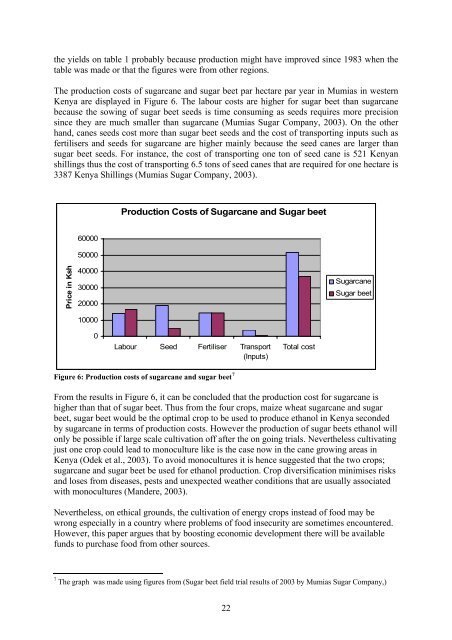The ma<strong>in</strong> types of biomass raw material from which <strong>ethanol</strong> can be produced <strong>in</strong>clude: sugarbear<strong>in</strong>g materials such as sugarcane <strong>and</strong> sugar beet; starches such as maize <strong>and</strong> cassava; <strong>and</strong>celluloses such as wood <strong>and</strong> agricultural residues (Thomas et al., 2001). Kenya has thepossibility of produc<strong>in</strong>g <strong>ethanol</strong> from maize, wheat sugarcane <strong>and</strong> sugar beet.Maize <strong>and</strong> wheat could be <strong>use</strong>d to produce <strong>ethanol</strong>: they are both grown on large scale <strong>and</strong> doquite well <strong>in</strong> the country. However, it can be speculated that s<strong>in</strong>ce maize <strong>and</strong> wheat areproduced <strong>for</strong> human food consumption divert<strong>in</strong>g them from food to <strong>fuel</strong>s could lead to foodshortages <strong>and</strong> food <strong>in</strong>security. This could be <strong>in</strong> <strong>for</strong>m of <strong>in</strong>creased prices <strong>for</strong> the food crops ifthey are also <strong>use</strong>d <strong>for</strong> energy. However, the reverse appears to be true; it is suggested that thecultivation of crops that can serve both as energy crops <strong>and</strong> as food crops such as <strong>in</strong> this casemaize <strong>and</strong> wheat could help avoid the competition <strong>for</strong> l<strong>and</strong> <strong>and</strong> other resources betweenenergy crops <strong>and</strong> food crops (IDRC, 1994). This is beca<strong>use</strong> the cultivation of food crops willserve both as food <strong>and</strong> energy crops. Nevertheless the <strong>use</strong> of maize <strong>and</strong> or wheat <strong>for</strong> <strong>ethanol</strong><strong>production</strong> <strong>in</strong> Kenya could be more expensive due to the additional costs that will be <strong>in</strong>curredby the need <strong>for</strong> an additional step (saccharification) which is required to break down starches<strong>in</strong>to simple sugars; both maize <strong>and</strong> wheat are starches <strong>and</strong> will thus require this extra step(Thomas et al., 2001). Nevertheless dur<strong>in</strong>g a (personal communication with crop physiologist)it was po<strong>in</strong>ted out that depend<strong>in</strong>g on the market conditions there could be will<strong>in</strong>gness on theside of <strong>in</strong>terested parties to <strong>in</strong>vest <strong>in</strong> the additional saccharification step. In addition bothmaize <strong>and</strong> wheat have the disadvantage of that unlike sugarcane they will not produce bagasse<strong>for</strong> cogeneration thereby more costs will be <strong>in</strong>curred <strong>in</strong> the purchase of <strong>fuel</strong> (Thomas, 2001).From table 2, under optimum conditions, sugarcane would produce the highest quantity of<strong>ethanol</strong> per year. In addition, proponents of sugarcane argue that produc<strong>in</strong>g <strong>ethanol</strong> fromsugarcane would, <strong>in</strong> terms of <strong>fuel</strong>, be self susta<strong>in</strong><strong>in</strong>g s<strong>in</strong>ce energy to be <strong>use</strong>d <strong>for</strong> thedistillation process can be generated by cogeneration from bagasse (Thomas et al., 2001;BOSTID, 1983). However the disadvantage of the sugarcane crop <strong>for</strong> <strong>in</strong>stance <strong>in</strong> Kenya isthat it takes a long time (18-24 months) to mature (M<strong>and</strong>ere, 2003). This problem has <strong>in</strong> thepast led to the problem of immature harvest<strong>in</strong>g of sugarcane by farmers (M<strong>and</strong>ere, 2003,Odek et al., 2003).The second alternative would be to <strong>use</strong> sugar beet <strong>for</strong> <strong>ethanol</strong> <strong>production</strong>. The strong po<strong>in</strong>ts<strong>for</strong> sugar beet is that it has the advantage of time beca<strong>use</strong> as opposed to sugarcane which takesalmost two years to mature, sugar beet matures <strong>in</strong> 5 to 6 months; <strong>in</strong> addition, studies haveproved that sugar beet can grow <strong>in</strong> a wide variety of soils <strong>and</strong> climatic conditions giv<strong>in</strong>g anopportunity <strong>for</strong> different regions <strong>in</strong> the country the chance to cultivate it (M<strong>and</strong>ere, 2003). It isalso less water dem<strong>and</strong><strong>in</strong>g as compared to sugarcane (personal communication with cropphysiologist)The limit<strong>in</strong>g factor <strong>for</strong> us<strong>in</strong>g sugar beet is that <strong>in</strong> Kenya sugar beet is still on trials <strong>and</strong> theonly source of sugar beet now would be from the few farmers that are cultivat<strong>in</strong>g it <strong>in</strong> trialfields <strong>in</strong> western <strong>and</strong> central prov<strong>in</strong>ces of Kenya. However results from the field <strong>in</strong>dicate thatthe sugar beets are thriv<strong>in</strong>g well <strong>and</strong> have a big potential <strong>in</strong> Kenya (Kiriita 2001, 2002, 2003).The latest figures on yield after a period of 6 months - the time that it takes <strong>for</strong> sugar beet tomature - from Syngenta Seeds <strong>in</strong>ternal field trials <strong>in</strong>dicate a yield of 90 -120 tons per hectare<strong>for</strong> Sudan <strong>and</strong> 100-120 tons per hectare <strong>for</strong> Colombia (Kenneth Fredlund, Syngenta Seeds,personal communication, 2005) while <strong>in</strong> Kenya the yields are reported as be<strong>in</strong>g at an averageof 118 tons per hectare (Mumias Sugar Company, 2003). These figures are much higher than21
the yields on table 1 probably beca<strong>use</strong> <strong>production</strong> might have improved s<strong>in</strong>ce 1983 when thetable was made or that the figures were from other regions.The <strong>production</strong> costs of sugarcane <strong>and</strong> sugar beet par hectare par year <strong>in</strong> Mumias <strong>in</strong> westernKenya are displayed <strong>in</strong> Figure 6. The labour costs are higher <strong>for</strong> sugar beet than sugarcanebeca<strong>use</strong> the sow<strong>in</strong>g of sugar beet seeds is time consum<strong>in</strong>g as seeds requires more precisions<strong>in</strong>ce they are much smaller than sugarcane (Mumias Sugar Company, 2003). On the otherh<strong>and</strong>, canes seeds cost more than sugar beet seeds <strong>and</strong> the cost of transport<strong>in</strong>g <strong>in</strong>puts such asfertilisers <strong>and</strong> seeds <strong>for</strong> sugarcane are higher ma<strong>in</strong>ly beca<strong>use</strong> the seed canes are larger thansugar beet seeds. For <strong>in</strong>stance, the cost of transport<strong>in</strong>g one ton of seed cane is 521 Kenyanshill<strong>in</strong>gs thus the cost of transport<strong>in</strong>g 6.5 tons of seed canes that are required <strong>for</strong> one hectare is3387 Kenya Shill<strong>in</strong>gs (Mumias Sugar Company, 2003).Production Costs of Sugarcane <strong>and</strong> Sugar beet6000050000Price <strong>in</strong> Ksh.40000300002000010000SugarcaneSugar beet0Labour Seed Fertiliser Transport(Inputs)Total costFigure 6: Production costs of sugarcane <strong>and</strong> sugar beet 7From the results <strong>in</strong> Figure 6, it can be concluded that the <strong>production</strong> cost <strong>for</strong> sugarcane ishigher than that of sugar beet. Thus from the four crops, maize wheat sugarcane <strong>and</strong> sugarbeet, sugar beet would be the optimal crop to be <strong>use</strong>d to produce <strong>ethanol</strong> <strong>in</strong> Kenya secondedby sugarcane <strong>in</strong> terms of <strong>production</strong> costs. However the <strong>production</strong> of sugar beets <strong>ethanol</strong> willonly be possible if large scale cultivation off after the on go<strong>in</strong>g trials. Nevertheless cultivat<strong>in</strong>gjust one crop could lead to monoculture like is the case now <strong>in</strong> the cane grow<strong>in</strong>g areas <strong>in</strong>Kenya (Odek et al., 2003). To avoid monocultures it is hence suggested that the two crops;sugarcane <strong>and</strong> sugar beet be <strong>use</strong>d <strong>for</strong> <strong>ethanol</strong> <strong>production</strong>. Crop diversification m<strong>in</strong>imises risks<strong>and</strong> loses from diseases, pests <strong>and</strong> unexpected weather conditions that are usually associatedwith monocultures (M<strong>and</strong>ere, 2003).Nevertheless, on ethical grounds, the cultivation of energy crops <strong>in</strong>stead of food may bewrong especially <strong>in</strong> a country where problems of food <strong>in</strong>security are sometimes encountered.However, this paper argues that by boost<strong>in</strong>g economic development there will be availablefunds to purchase food from other sources.7 The graph was made us<strong>in</strong>g figures from (Sugar beet field trial results of 2003 by Mumias Sugar Company,)22
















